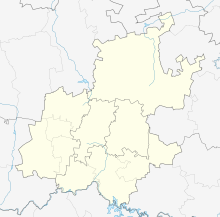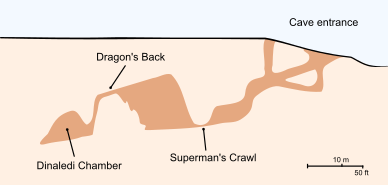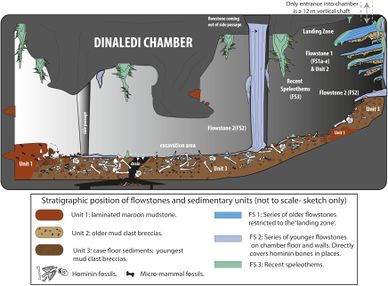كهف النجم الصاعد
| Rising Star Cave | |
|---|---|
 استكشاف الكهف | |
| الموقع | بالقرب من كروگرزدورپ في بلدية وست راند في مقاطعة گاوتنگ، جنوب أفريقيا |
| الاحداثيات | 25°55′04″S 27°47′08″E / 25.91778°S 27.78556°E |
The Rising Star cave system (also known as Westminster or Empire cave) is located in the Malmani dolomites, in Bloubank River valley, about 800 meters (0.50 miles; 2,600 feet) southwest of Swartkrans, part of the Cradle of Humankind World Heritage Site in South Africa.[1][2] Recreational caving has occurred there since the 1960s.[2] Fossils found (starting in 2013) in the cave were, in 2015, proposed to represent a previously unknown extinct species of hominin named Homo naledi.[1]
. . . . . . . . . . . . . . . . . . . . . . . . . . . . . . . . . . . . . . . . . . . . . . . . . . . . . . . . . . . . . . . . . . . . . . . . . . . . . . . . . . . . . . . . . . . . . . . . . . . . . . . . . . . . . . . . . . . . . . . . . . . . . . . . . . . . . . . . . . . . . . . . . . . . . . . . . . . . . . . . . . . . . . . .
الأسماء
In the 1980s, the names "Empire", "Westminster", and "Rising Star" were used interchangeably.[3]
The species name, naledi (seSotho for "star"), and the "Dinaledi Chamber" (incorporating the Sotho word for "stars")[4] were so named by members of the Rising Star Expedition in reference to the species and chamber's location in Rising Star Cave.[1][4][5]
A portion of the cave, used by the excavation team en route to the Dinaledi Chamber, is called "Superman's Crawl" because most people can fit through only by holding one arm tightly against the body and extending the other above the head, in the manner of Superman in flight.[2][5]
The Superman Crawl opens into the "Dragon's Back Chamber," which includes an approximately 15 m (49 foot) exposed climb up a ridge of a sharp-edged dolomite block that fell from the roof sometime in the distant past. This block is the so-called Dragon's Back, so named because the climbing route appears to progress from the tail to the head along the spiked spine of a mythical beast.[5]
History
Geologists think the cave in which the fossils were discovered is no older than three million years.[6]
The cave was explored in the 1980s by the Speleological Exploration Club (SEC), a local branch of the South African Speleological Association (SASA).[3]
Discovery of fossils in "Dinaledi Chamber"
On 13 September 2013, while exploring the Rising Star cave system, recreational cavers Rick Hunter and Steven Tucker of the Speleological Exploration Club (SEC) found a narrow, vertically oriented "chimney" or "chute" measuring 12 m (39 ft) long with an average width of 20 cm (7.9 in).[2][5][7][8] Then Hunter discovered a room 30 m (98 ft) underground (Site U.W. 101, the Dinaledi Chamber), the surface of which was littered with fossil bones. On 1 October, photos of the site were shown to Pedro Boshoff and then to Lee Berger, both of the University of the Witwatersrand.[7][9]
The arrangement of bones, as well as several survey pegs, suggested "someone had already been there" as recently as a few decades earlier.[2][5] The appearance of limited fossilisation initially led the explorers to think the bones were from the last caver into the chamber, who had subsequently never made it back out alive.[2]
2013 and 2014 excavations
Berger organized an expedition to excavate the fossils, which started on 7 November 2013.[9] The expedition was funded by the South African National Research Foundation and the National Geographic Society.[10][11]
The excavation team enlisted six paleoanthropologists, all of whom were women, who could pass through an opening only 18 cm (7 inches) wide to access the Dinaledi Chamber.[9][12][13] Those chosen were Hannah Morris, Marina Elliott, Becca Peixotto, Alia Gurtov, Lindsay Eaves, and Elen Feuerriegel.[14] They have since been nicknamed the Underground Astronauts.[15]
The Dinaledi Chamber was assigned the designation UW-101 and was excavated by these six members of the Rising Star Expedition during November 2013. More than 1,200 fossil elements were recovered and catalogued in November 2013,[16] representing at least a dozen individuals.[17] Only 20 out of 206 bones in the human body were not found in the cave as of Summer 2014.[18] By April 2014, between two localities, 1,754 specimens were recovered.[19]
The layered distribution of the bones [in clay-rich sediments] suggests that they had been deposited over a long period of time, perhaps centuries.[2][5] Only one square meter of the cave chamber has been excavated; other remains might still be there.[5][10][20][21]
On 20 February 2014, Rick Hunter, Lee Berger, John Hawks, Alia Gurtov, and Pedro Boshoff returned to Rising Star to evaluate a second potential site. The site, designated UW-102, was found by cavers Rick Hunter and Steve Tucker on the last day of the first Rising Star Expedition, and limited excavation began in April 2014.[19][22]
اعتبارا من سبتمبر 2015[تحديث], fossils of at least fifteen individuals, amounting to 1,550 specimens, had been excavated from the cave.[1][2] About 300 bone fragments were collected from the surface of the Dinaledi Chamber, and about 1,250 fossil specimens were recovered from the chamber's main excavation pit, Unit 3.[5] The fossils include skulls, jaws, ribs, teeth, bones of an almost complete foot, of a hand, and of an inner ear. The bones of both old and young individuals, as well as infants, were found.[1][2]
The 15 partial skeletons, which were found in a small underground chamber, invite speculation on the circumstances of their location. Paleoanthropologist John D. Hawks, from the University of Wisconsin-Madison, who is a member of the team, has stated that the scientific facts are that all the bones recovered are hominin, except for those of one owl; there are no signs of predation, and there is no predator that accumulates only hominins this way; the bones did not accumulate there all at once. There is no evidence of rocks or sediment having dropped into the cave from any opening in the surface; no evidence of water flowing into the cave carrying the bones into the cave.[5][23][24] Hawks concluded that the best hypothesis is that the bodies were deliberately placed in the cave after death, by other members of the species.[25] Berger et al. suggest that "these individuals were capable of ritual behaviour." They speculate the placing of dead bodies in the cave was a ritualistic behaviour, a sign of symbolic thought.[26] "Ritual" here means an intentional and repeated practice (disposing of dead bodies in the cave), and not implying any type of religious ritual.[6] This hypothesis has been criticised for its improbability.[27][28]
A study involving the statistical reconstruction of hominin evolutionary trees from skull and tooth measurements, indicates that the most likely age for H. naledi is 912 kya.[29][30][31]
The age of the original Homo naledi remains from the Dinaledi Chamber has been revealed to be startlingly young in age. Homo naledi, which was first announced in September 2015, was alive sometime between 335 and 236 thousand years ago. This places this population of primitive small-brained hominins at a time and place that it is likely they lived alongside Homo sapiens.
The Tswaing crater, some 220,000 ± 52,000 years old, lies only 70 km distant.
A collaborative workshop involving 54 local and international scientists took place in May 2014 at the University of the Witwatersrand,[2][19][32] On 10 September 2015, the fossils were publicly unveiled and given the name Homo naledi.[1][5]
Dating
The fossils of the Dinaledi chamber have been dated to between 335,000 and 236,000 years ago, long after much larger-brained and more modern-looking hominins had appeared.[33][34] Geologists estimate that the cave in which the fossils were discovered is no older than three million years,[6] and the ages for flowstone where the fossils were recovered from was interpreted to be deposited between 236,000 and 414,000 years ago.[33]
Geology
The Rising Star cave system lies in the Bloubank River valley, 2.2 km west of Sterkfontein Cave. It comprises an area of 250 × 150 m of mapped passageways situated in the core of a gently west dipping (17°) open fold, and it is stratigraphically bound to a 15–20 m-thick, stromatolitic dolomite horizon in the lower parts of the Monte Christo Formation. This dolomite horizon is largely chert-free but contains five thin (<10 cm) chert marker horizons that have been used to evaluate the relative position of chambers within the system. The upper contact is marked by a 1–1.3 m-thick, capping chert unit that forms the roof of several large cave chambers.[5] The altitude above sea level is 1,450 m for the Dinaledi Chamber's floor.[35]
See also
- Dawn of Humanity (2015 PBS film)
- Gondolin Cave
References
- ^ أ ب ت ث ج ح Berger, Lee R.; et al. (10 September 2015). "Homo naledi, a new species of the genus Homo from the Dinaledi Chamber, South Africa". eLife. 4. doi:10.7554/eLife.09560. PMC 4559886. PMID 26354291.
{{cite journal}}: Unknown parameter|lay-url=ignored (help)CS1 maint: unflagged free DOI (link) - ^ أ ب ت ث ج ح خ د ذ ر Shreeve, Jamie (10 September 2015). "This Face Changes the Human Story. But How?". National Geographic News. Retrieved 2015-09-10.
- ^ أ ب Paul Courbon (1989). Atlas of the Great Caves of the World. Cave Books. p. 38. ISBN 0939748215.
Empire Cave [Western Transvaal]: 4010 m; Empire/Westminster/Rising Star Cave. Explored by SASA and Free Cavers
- ^ أ ب Sesotho dinaledi is a class 10 plural noun built on the class 9 noun naledi "star" (Bukantswe v.3 dictionary).
- ^ أ ب ت ث ج ح خ د ذ ر ز Dirks, Paul H. G. M.; et al. (2015). "Geological and taphonomic context for the new hominin species Homo naledi from the Dinaledi Chamber, South Africa". eLife. 4: e09561. doi:10.7554/eLife.09561. ISSN 2050-084X. PMC 4559842. PMID 26354289.
{{cite journal}}: CS1 maint: unflagged free DOI (link)Full list of authors- Paul HGM Dirks
- Lee R Berger
- Eric M Roberts
- Jan D Kramers
- John Hawks
- Patrick S Randolph-Quinney
- Marina Elliott
- Charles M Musiba
- Steven E Churchill
- Darryl J de Ruiter
- Peter Schmid
- Lucinda R Backwell
- Georgy A Belyanin
- Pedro Boshoff
- K Lindsay Hunter
- Elen M Feuerriegel
- Alia Gurtov
- James du G Harrison
- Rick Hunter
- Ashley Kruger
- Hannah Morris
- Tebogo V Makhubela
- Becca Peixotto
- Steven Tucker
- ^ أ ب ت Wilford, John Noble (10 September 2015). "New Species in Human Lineage Is Found in a South African Cave". New York Times. ISSN 0362-4331. Retrieved 2015-09-10.
- ^ أ ب Tucker, Steven (13 November 2013). "Rising Star Expedition". Speleological Exploration Club. Retrieved 8 September 2015.
- ^ André Doussy. "SEC-Caving: Rising Star Expedition Finds over 1,000 Hominid Fossils". sec-caving.co.za.
- ^ أ ب ت Yong, Ed (10 September 2015). "6 Tiny Cavers, 15 Odd Skeletons, and 1 Amazing New Species of Ancient Human". The Atlantic. Retrieved 2015-09-13.
- ^ أ ب Greenfieldboyce, Nell (10 September 2015). "South African Cave Yields Strange Bones Of Early Human-Like Species". NPR. Retrieved 2015-09-10.
- ^ "Rising Star Expedition - National Geographic (blogs)". nationalgeographic.com. Archived from the original on 2015-09-09.
- ^ Staff (6 نوفمبر 2013). "Rising Star Expedition Launched". University of the Witwatersrand. Archived from the original on 13 سبتمبر 2015. Retrieved 8 سبتمبر 2015.
- ^ Brahic, Catherine (26 November 2014). "Bone Bonanza: Chamber of Secrets Yields Human Remains". New Scientist. Retrieved 2015-09-08.
- ^ Smith, David (10 September 2015). "'Small spelunkers required': the ad that led to the discovery of Homo naledi". The Guardian. Retrieved 10 January 2016.
- ^ Feltman, Rachel (September 10, 2015). "Meet the six female 'underground astronauts' who recovered our newest relative". The Washington Post. Retrieved 10 January 2016.
- ^ Andrew Howley. "Final Day of Excavations". nationalgeographic.com.
- ^ "Anthropologist, 'underground astronaut' strike fossil gold in South Africa dig".
- ^ "Anthropology Prof. John Hawks and UW-Madison students dig up crucial remnants of early hominids".
- ^ أ ب ت Lee R. Berger. "Rising Star Empire Cave 2014 Annual Report".
- ^ Alford, Justine (10 September 2015). "New Species Of Human Discovered In South Africa".
- ^ Shreeve, Jamie (10 September 2015). "New Human Ancestor Elicits Awe—and Many Questions". National Geographic Society. Retrieved 2015-09-17.
- ^ Hawks, John. "Scientists Return to Explore a Second Fossil Chamber".
- ^ Drake, Nadia (15 September 2015). "Mystery Lingers Over Ritual Behavior of New Human Ancestor". National Geographic News. Retrieved 2015-09-16.
- ^ McKensie, David (10 September 2015). "Homo naledi: Scientists find ancient human relative" (Video (02:43)). CNN News. Retrieved 2015-09-13.
- ^ Staff (10 September 2015). "Dawn of Humanity". PBS. Retrieved 2015-09-14.
Documentary time mark: 1h 40 min
- ^ Ghosh, Pallab (10 September 2015). "New human-like species discovered in S Africa". BBC News. Retrieved 2015-09-10.
- ^ Sample, Ian (10 September 2015). "Homo naledi: new species of ancient human discovered, claim scientists". The Guardian. Retrieved 2016-01-06.
- ^ Wong, Kate. "Debate Erupts over Strange New Human Species". Retrieved 2016-07-06.
- ^ Dembo, Mana; Radovčić, Davorka; Garvin, Heather M.; Laird, Myra F.; Schroeder, Lauren; Scott, Jill E.; Brophy, Juliet; Ackermann, Rebecca R.; Musiba, Chares M. (2016-08-01). "The evolutionary relationships and age of Homo naledi: An assessment using dated Bayesian phylogenetic methods". Journal of Human Evolution. 97: 17–26. doi:10.1016/j.jhevol.2016.04.008. hdl:2164/8796. PMID 27457542.
- ^ Bower, Bruce. "New dating suggests younger age for Homo naledi". Retrieved 2016-07-06.
- ^ Thackeray, J. Francis (2015). "Estimating the age and affinities of Homo naledi" (PDF). South African Journal of Science. 111 (11/12). doi:10.17159/sajs.2015/a0124. Retrieved July 6, 2016.
- ^ "Crowdsourcing digs up an early human species". Nature News & Comment.
- ^ أ ب Dirks, Paul H.G.M.; Roberts, Eric M.; et al. (9 May 2017). "The age of Homo naledi and associated sediments in the Rising Star Cave, South Africa". eLife. 6: e24231. doi:10.7554/eLife.24231. PMC 5423772. PMID 28483040.Full list of authors
- Paul H.G.M. Dirks
- Eric M. Roberts
- Hannah Hilbert-Wolf
- Jan D. Kramers
- John Hawks
- Anthony Dosseto
- Mathieu Duval
- Marina Elliott
- Mary Evans
- Rainer Grün
- John Hellstrom
- Andy I.R. Herries
- Renaud Joannes-Boyau
- Tebogo V. Makhubela
- Christa J. Placzek
- Jessie Robbins
- Carl Spandler
- Jelle Wiersma
- Jon Woodhead
- Lee R. Berger
- ^ Rincon, Paul (9 May 2017). "Amazing haul of ancient human finds unveiled". BBC. Retrieved 9 May 2017.
- ^ "New species of extinct human found in cave may rewrite history". New Scientist.
. . . . . . . . . . . . . . . . . . . . . . . . . . . . . . . . . . . . . . . . . . . . . . . . . . . . . . . . . . . . . . . . . . . . . . . . . . . . . . . . . . . . . . . . . . . . . . . . . . . . . . . . . . . . . . . . . . . . . . . . . . . . . . . . . . . . . . . . . . . . . . . . . . . . . . . . . . . . . . . . . . . . . . . .
External links
- CS1 errors: unsupported parameter
- CS1 maint: unflagged free DOI
- Short description is different from Wikidata
- Pages using gadget WikiMiniAtlas
- Wikipedia cave articles with unreferenced coordinates
- Pages using multiple image with auto scaled images
- Pages using multiple image with manual scaled images
- مقالات فيها عبارات متقادمة منذ سبتمبر 2015
- جميع المقالات التي فيها عبارات متقادمة
- Archaeological sites in South Africa
- Caves of South Africa
- كهوف حجر جيري
- Landforms of Gauteng
- Paleoanthropological sites
- South African heritage sites



